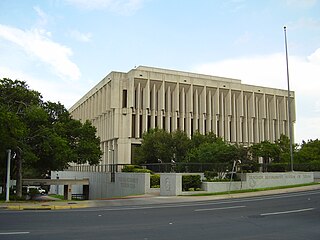Related Research Articles
A layoff or downsizing is the temporary suspension or permanent termination of employment of an employee or, more commonly, a group of employees for business reasons, such as personnel management or downsizing an organization. Originally, layoff referred exclusively to a temporary interruption in work, or employment but this has evolved to a permanent elimination of a position in both British and US English, requiring the addition of "temporary" to specify the original meaning of the word. A layoff is not to be confused with wrongful termination. Laid off workers or displaced workers are workers who have lost or left their jobs because their employer has closed or moved, there was insufficient work for them to do, or their position or shift was abolished. Downsizing in a company is defined to involve the reduction of employees in a workforce. Downsizing in companies became a popular practice in the 1980s and early 1990s as it was seen as a way to deliver better shareholder value as it helps to reduce the costs of employers. Research on downsizing in the US, UK, and Japan suggests that downsizing is being regarded by management as one of the preferred routes to help declining organizations, cutting unnecessary costs, and improve organizational performance. Usually a layoff occurs as a cost-cutting measure. A study of 391 downsizing announcements of the S&P 100 firms for the period 1990-2006 found, that layoff announcements resulted in substantial increase in the companies’ stock prices, and that the gain was larger, when the company had prior layoffs. The authors suggested, that the stock price manipulation alone creates a sufficient motivation for publicly-traded corporations to adopt the practice of regular layoffs.

Cost of living is the cost of maintaining a certain standard of living. Changes in the cost of living over time can be operationalized in a cost-of-living index. Cost of living calculations are also used to compare the cost of maintaining a certain standard of living in different geographic areas. Differences in cost of living between locations can be measured in terms of purchasing power parity rates. An sharp rise in the cost of living can trigger a cost of living crisis where purchasing power is lost and the previous lifestyle is no longer affordable.
In the United States Navy, officers have various ranks. Equivalency between services is by pay grade. United States Navy commissioned officer ranks have two distinct sets of rank insignia: On dress uniform a series of stripes similar to Commonwealth naval ranks are worn; on service khaki, working uniforms, and special uniform situations, the rank insignia are identical to the equivalent rank in the US Marine Corps.

The United States Office of Personnel Management (OPM) is an independent agency of the United States government that manages the United States federal civil service. The agency provides federal human resources policy, oversight, and support, and tends to healthcare (FEHB), life insurance (FEGLI), and retirement benefits for federal government employees, retirees, and their dependents.

The U.S. Railroad Retirement Board (RRB) is an independent agency in the executive branch of the United States government created in 1935 to administer a social insurance program providing retirement benefits to the country's railroad workers.
A qualified domestic relations order, is a judicial order in the United States, entered as part of a property division in a divorce or legal separation that splits a retirement plan or pension plan by recognizing joint marital ownership interests in the plan, specifically the former spouse's interest in that spouse's share of the asset. A QDRO's recognition of spousal ownership interest in a plan participant's (employee's) pension plan awards a portion of the plan participant's benefit to an alternate payee. An alternate payee must be a spouse, former spouse, child or other dependent of the plan participant. A QDRO may also be entered for spousal support or child support.

The Thrift Savings Plan (TSP) is a defined contribution plan for United States civil service employees and retirees as well as for members of the uniformed services. As of December 31, 2021, TSP has approximately 6.5 million participants, and more than $827.2 billion in assets under management; it is the largest defined contribution plan in the world. The TSP is administered by the Federal Retirement Thrift Investment Board, an independent agency.
The Civil Service Retirement System (CSRS) is a public pension fund organized in 1920 that has provided retirement, disability, and survivor benefits for most civilian employees in the United States federal government. Upon the creation of a new Federal Employees Retirement System (FERS) in 1987, those newly hired after that date cannot participate in CSRS. CSRS continues to provide retirement benefits to those eligible to receive them.
The Federal Employees' Retirement System (FERS) is the retirement system for employees within the United States civil service. FERS became effective January 1, 1987, to replace the Civil Service Retirement System (CSRS) and to conform federal retirement plans in line with those in the private sector.

The Senior Executive Service (SES) is a position classification in the civil service of the United States federal government equivalent to general officer or flag officer rank in the U.S. Armed Forces. It was created in 1979 when the Civil Service Reform Act of 1978 went into effect under President Jimmy Carter.
The General Schedule (GS) is the predominant pay scale within the United States civil service. The GS includes the majority of white collar personnel positions. As of September 2004, 71 percent of federal civilian employees were paid under the GS. The GG pay rates are identical to published GS pay rates.
The United States federal civil service is the civilian workforce of the United States federal government's departments and agencies. The federal civil service was established in 1871. U.S. state and local government entities often have comparable civil service systems that are modeled on the national system to varying degrees.
In the United States, public sector pensions are offered at the federal, state, and local levels of government. They are available to most, but not all, public sector employees. These employer contributions to these plans typically vest after some period of time, e.g. 5 years of service. These plans may be defined-benefit or defined-contribution pension plans, but the former have been most widely used by public agencies in the U.S. throughout the late twentieth century. Some local governments do not offer defined-benefit pensions but may offer a defined contribution plan. In many states, public employee pension plans are known as Public Employee Retirement Systems (PERS).
Title 10 of the United States Code outlines the role of armed forces. It provides the legal basis for the roles, missions and organization of each of the services as well as the United States Department of Defense. Each of the five subtitles deals with a separate aspect or component of the armed services.
The United States Internal Revenue Service (IRS) uses forms for taxpayers and tax-exempt organizations to report financial information, such as to report income, calculate taxes to be paid to the federal government, and disclose other information as required by the Internal Revenue Code (IRC). There are over 800 various forms and schedules. Other tax forms in the United States are filed with state and local governments.
Title 5 of the United States Code is a positive law title of the United States Code with the heading "Government Organization And Employees."
Congressional pension is a pension made available to members of the United States Congress. As of 2019, members who participated in the congressional pension system are vested after five years of service. A pension is available to members 62 years of age with 5 years of service; 50 years or older with 20 years of service; or 25 years of service at any age. A reduced pension is available depending upon which of several different age/service options is chosen. If Members leave Congress before reaching retirement age, they may leave their contributions behind and receive a deferred pension later. The current pension program, effective January 1987, is under the Federal Employees Retirement System (FERS), which covers members and other federal employees whose federal employment began in 1984 or later. This replaces the older Civil Service Retirement System (CSRS) for most members of congress and federal employees.

Teacher Retirement System of Texas (TRS) is a public pension plan of the State of Texas. Established in 1937, TRS provides retirement and related benefits for those employed by the public schools, colleges, and universities supported by the State of Texas and manages a $180 billion trust fund established to finance member benefits. More than 1.6 million public education and higher education employees and retirees participate in the system. TRS is the largest public retirement system in Texas in both membership and assets and the sixth largest public pension fund in America. The agency is headquartered at 1000 Red River Street in the capital city of Austin.
Pensions in Norway fall into three major divisions; State Pensions, Occupational Pensions and Individual or personal Pensions.

The structure of the United States Congress with a separate House and Senate is complex with numerous committees handling a disparate array of topics presided over by elected officers. Some committees manage other committees. Congresspersons have various privileges to help the presidents serve the national interest and are paid a salary and have pensions. Congress formed a Library of Congress to help assist investigations and developed a Government Accountability Office to help it analyze complex and varied federal expenditures.